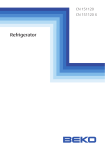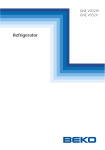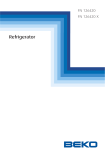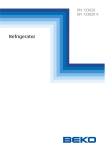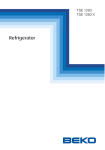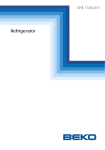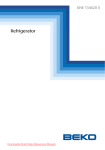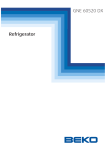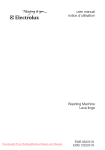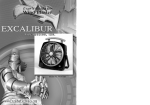Download Beko DNE 25020 Instruction manual
Transcript
DNE 25020 DNE 25020 S Refrigerator Please read this manual first! Dear Customer, We hope that your product, which has been produced in modern plants and checked under the most meticulous quality control procedures, will provide you an effective service. For this, we recommend you to carefully read the entire manual of your product before using it and keep it at hand for future references. This manual • Will help you use your appliance in a fast and safe way. • Read the manual before installing and operating your product. • Follow the instructions, especially those for safety. • Keep the manual in an easily accessible place as you may need it later. • Besides, read also the other documents provided with your product. Please note that this manual may be valid for other models as well. Symbols and their descriptions This instruction manual contains the following symbols: Important information or useful usage tips. C A Warning against dangerous conditions for life and property. B Warning against electric voltage. Recycling This product is supplied with the selective sorting symbol for waste electrical and electronic equipment (WEEE). This means that this product must be handled pursuant to European Directive 2002/96/EC in order to be recycled or dismantled to minimise its impact on the environment. For further information, please contact your local or regional authorities. Electronic products not included in the selective sorting process are potentially dangerous for the environment and human health due to the presence of hazardous substances. www.beko.com This product was manufactured using the latest technology in environmentally friendly conditions. CONTENTS 1 Your refrigerator 3 2 Important Safety Warnings 4 4 Preparation 5 Using your refrigerator 12 Intended use...................................... 4 For products with a water dispenser;.. 6 Child safety......................................... 6 HCA Warning..................................... 6 Things to be done for energy saving... 6 3 Installation 11 Fridge compartment thermostat setting button ............................................. 12 Freezer compartment thermostat setting button .................................. 13 Making ice........................................ 13 6 Maintenance and cleaning 7 Points to be considered when retransporting your refrigerator.............. 7 Before operating your refrigerator....... 7 Adjusting the feet................................ 8 Electric connection............................. 8 Disposing of the packaging................ 8 Disposing of your old refrigerator........ 8 Replacing the interior light bulb . ........ 9 Reversing the doors......................... 10 2 14 Protection of plastic surfaces . ......... 14 7 Recommended solutions for the problems 15 8 Beko Customer Care EN 18 1 Your refrigerator 13 1 2 10 3 4 11 5 12 6 5 12 14 5 7 12 8 9 1. 2. 3. 4. 5. 6. 7. Freezer compartment shelf Thermostat control Ice container Fridge compartment temperature setting button Adjustable body shelves İnterior light Crisper cover 8. 9. 10. 11. 12. 13. 14. Crisper Adjustable feet Freezer compartment door shelf Egg tray Fridge compartment door shelf Freezer compartment Fridge compartment Figures that are shown in this instruction manual are schematic and may not correspond exactly with your product. If the subject parts are not included in the product you have purchased, then it is valid for other models. 3 EN 2 Important Safety Warnings Please review the following information. Failure to observe this information may cause injuries or material damage. Otherwise, all warranty and reliability commitments will become invalid. • Unplug your refrigerator before cleaning or defrosting. • Pressure or spray cleaning materials should never be used in cleaning and defrosting processes of your refrigerator. In such cases, the solution may Intended use get in contact with the electrical parts This product is intended to be used and cause short circuit or electric – indoors and in closed areas such as shock. homes; • Never use the parts on your refrigera– in closed working environments such tor such as the door as a means of as stores and offices; support or step. – in closed accommodation areas such • Do not use electrical devices inside as farm houses, hotels,with retirement the refrigerator. homes. • Do not drill or cut the refrigerator as • This product should not be used you may release the refrigerant gas. outdoors. This may cause irritation to the skin or injury to the eye. .• Do not cover or block the ventilation General safety holes on your refrigerator with any • When you want to dispose/scrap the material. product, we recommend you consult • Electrical devices must be repaired the authorized service agent in order by only authorised persons. Repairs to learn the required information and performed by incompetent persons authorized bodies. create a risk for the user. • Consult your authorized service agent • In case of any failure or during a for all your questions and problems maintenance or repair work, disconrelated to the refrigerator. Do not nect your refrigerator’s mains supply intervene or let someone intervene to by either turning off the relevant fuse the refrigerator without notifying the or unplugging your appliance. authorised services. • Do not pull by the cable when pulling • For products with a freezer compartthe plug out of the wall socket. ment; Caution, eating of ice cream or • Place the beverage with higher proofs ice cubes immediately after removing tightly closed and vertically. from freezer may cause discomfort due • Never store spray cans containing to the extreme cold. flammable and explosive substances • For products with a freezer compartin the refrigerator. ment; Do not put bottled and canned liquid beverages in the freezer compart- • Do not use mechanical devices or other means to accelerate the ment. Otherwise, these may burst. defrosting process, other than those • Do not touch frozen food by hand; they recommended by the manufacturer. may stick to your hand. 4 EN • Do not operate a damaged refrigerator. Consult with the service agent if you have any concerns. • Electrical safety of your refrigerator shall be guaranteed only if the earth system in your house complies with standards. • Exposing the product to rain, snow, sun and wind is dangerous with respect to electrical safety. • Contact your authorised service agent in the event of damage caused to your power cable. • Please contact an authorised electrician in the event of power cord damage. • Never plug the refrigerator into the wall outlet during installation. Otherwise, risk of death or serious injury may arise. • This refrigerator is intended for only storing food items. It must not be used for any other purpose. • Label of technical specifications is located on the left wall inside the refrigerator. • Never connect your refrigerator to electricity-saving systems; they may damage the refrigerator. • If there is a blue light on the refrigerator, do not look at the blue light with optical tools. • For manually controlled refrigerators, wait for at least 5 minutes to start the refrigerator after power failure. • This operation manual should be handed in to the new owner of the product when it is given to others. • Avoid causing damage on power cable when transporting the refrigerator. Bending cable may cause fire. Never place heavy objects on power cable. Do not touch the plug with wet hands when plugging the product. 5 • Do not plug the refrigerator if the wall outlet is loose. • Water should not be sprayed directly on inner or outer parts of the product for safety purposes. • Do not spray substances containing inflammable gases such as propane gas near the refrigerator to avoid fire and explosion risk. • Never place containers filled with water on top of the refrigerator, otherwise this may cause electric shock or fire. • Do not overload your refrigerator with excessive amounts of food. If overloaded, the food items may fall down hurt you and damage refrigerator when you open the door. Never place objects on top of the refrigerator; otherwise, these objects may fall down when you open or close the refrigerator’s door. • As they require a precise temperature, vaccines, heat-sensitive medicine scientific materials etc. should not be kept in the refrigerator. • If not to be used for a long time, refrigerator should be unplugged. • The plug’s tip should be regularly cleaned; otherwise, it may cause fire. • Refrigerator may move if adjustable feet are not properly secured on the floor. Properly securing adjustable feet on the floor can prevent the refrigerator to move. EN • When carrying the refrigerator, do not hold it from door handle. Otherwise, it may snap or break. • When you have to place your product next to another refrigerator or freezer, the distance between devices should be at least 8cm. Otherwise, adjacent side walls may be humidified. For products with a water dispenser; For a mains connected system the minimum pressure should be 100 kpa and the maximum pressure should not exceed 800 kpa. • Use filtered water only. Child safety • If the door has a lock, the key should be kept away from reach of children. • Children must be supervised to prevent them from tampering with the product. HCA Warning If your product's cooling system contains R600a: This gas is flammable. Therefore, pay attention to not damaging the cooling system and piping during usage and transportation. In the event of damage, keep your product away from potential fire sources that can cause the product catch a fire and ventilate the room in which the unit is placed. 6 Things to be done for energy saving • Do not leave the doors of your refrigerator open for a long time. • Do not put hot food or drinks in your refrigerator. • Do not overload your refrigerator in a way that will prevent or restrict air circulation inside the cabinet. • Do not install your refrigerator under direct sunlight or near heat emitting appliances such as ovens, dishwashers or radiators. • Pay attention to keep your food in closed containers. • For products with a freezer compartment; You can store maximum amount of food items in the freezer when you remove the shelf or drawer of the freezer. Energy consumption value stated for your refrigerator has been determined by removing freezer shelf or drawer and under maximum load. There is no harm to use a shelf or drawer according to the shapes and size of food to be frozen. • Thawing frozen food in fridge compartment will both provide energy saving and preserve the food quality. EN 3 Installation Please remember that the manufacturer shall not be held liable if the information given in the instruction manual is not observed. Points to be considered when re-transporting your refrigerator 1. Your refrigerator must be emptied and cleaned prior to any transportation. 2. Shelves, accessories, crisper and etc. in your refrigerator must be fastened securely by adhesive tape against any jolt before repackaging. 3. Packaging must be tied with thick tapes and strong ropes and the rules of transportation printed on the package must be followed. Please remember… Every recycled material is an indispensable source for nature and for our national resources. If you wish to contribute to recycling the packaging materials, you can get further information from the environmental bodies or local authorities. 3. Clean the interior of the refrigerator as recommended in the “Maintenance and cleaning” section. 4. Plug the refrigerator into the wall outlet. When the fridge door is open the fridge compartment interior light will come on. 5. You will hear a noise as the compressor starts up. The liquid and gases sealed within the refrigeration system may also give rise to noise, even if the compressor is not running and this is quite normal. 6. Front edges of the refrigerator may feel warm. This is normal. These areas are designed to be warm to avoid condensation. Before operating your refrigerator Before starting to use your refrigerator check the following: 1. Is the interior of the refrigerator dry and can the air circulate freely in the rear of it? 2. Insert the 2 plastic wedges onto the rear ventilation as illustrated in the following figure. Plastic wedges will provide the required distance between your refrigerator and the wall in order to allow the air circulation. 7 EN Electric connection Connect your product to a grounded socket which is being protected by a fuse with the appropriate capacity. Important: The connection must be compliant with national regulations. The power cable plug must be easily accessible after installation. Voltage and permitted fuse protection are indicated in the “Specifications” section. The specified voltage must be equal to your mains voltage. Extension cables and multiway plugs must not be used for connection. A damaged power cable must be replaced by a qualified electrician. Product must not be operated before it is repaired! There is danger of electric shock! Disposing of the packaging The packing materials may be dangerous for children. Keep the packing materials out of the reach of children or dispose them of by classifying them in accordance with the waste instructions. Do not dispose them of along with the normal household waste. The packing of your refrigerator is produced from recyclable materials. 8 Disposing of your old refrigerator Dispose of your old machine without causing any harm to the environment. You may consult your authorized dealer or waste collection center of your municipality about the disposal of your refrigerator. Before disposing of your refrigerator, cut off the electric plug and, if there are any locks on the door, make them inoperable in order to protect children against any danger. Adjusting the feet If your refrigerator is unbalanced; You can balance your refrigerator by turning the front feet of it as illustrated in the figure. The corner where the leg exists is lowered when you turn it the direction of black arrow and raised when you turn in the opposite direction. Taking help from someone to slightly lift the refrigerator will facilitate this process. EN Replacing the interior light bulb Should the light fail to work switch off at the socket outlet and pull out the mains plug. Follow the below instructions to check if the light bulb has worked itself loose. If the light still fails to work obtain a replacement E14 screw cap type 15 Watt (Max) bulb from your local electrical store and then fit it as follows: 1. Switch off at the socket outlet and pull out the mains plug. You may find it useful to remove shelves for easy access. 2. Remove the light diffuser cover as shown in figure (a-b). 3. Replace the burnt-out light bulb. 4. Reassemble the light diffuser cover as shown in figure (c). “Push firmly to ensure cover is fitted properly.” 5. Carefully dispose of the burnt-out light bulb immediately. “Replacement light bulb can easily be obtained from a good local electrical or DIY store.” figure (a) figure (b) 9 EN Reversing the doors Proceed in numerical order 4 11 5 2 7 10 1 6 12 3 13 14 60° 9 8 15 19 18 180° 21 22 20 21 17 16 10 EN 4 Preparation C Your refrigerator should be installed at least 30 cm away from heat sources such as hobs, ovens, central heater and stoves and at least 5 cm away from electrical ovens and should not be located under direct sunlight. C The ambient temperature of the room where you install your refrigerator should at least be 10°C. Operating your refrigerator under cooler conditions than this is not recommended with regard to its efficiency. C Please make sure that the interior of your refrigerator is cleaned thoroughly. C If two refrigerators are to be installed side by side, there should be at least 2 cm distance between them. C When you operate your refrigerator for the first time, please observe the following instructions during the initial six hours. - The door should not be opened frequently. - It must be operated empty without any food in it. - Do not unplug your refrigerator. If a power failure occurs out of your control, please see the warnings in the “Recommended solutions for the problems” section. C Original packaging and foam materials should be kept for future transportations or moving. 11 EN 5 Using your refrigerator Fridge compartment thermostat setting button Thermostat button allows you to make the general temperature setting of your refrigerator. Thermostat button of the refrigerator controls both the temperature of the freezer compartment and the amount of the air sent to the fridge compartment and thus, the temperature of the fridge compartment. 5 4 3 5 4 3 Thermostat Controller must be set to a cooler position if the food is going to be frozen or large amounts of food will be loaded. If the food in the fridge compartment cools too much or freezes, thermostat controller must be set to position “1”. At regular room temperatures: Set the thermostat button to a position between “2 and 3” to store your food. At high room temperatures: 12 EN Freezer compartment thermostat setting button Freezer compartment setting controller can be set to a position between Normal and Quick Freezing. • In low room temperatures, it is suggested to set the freezer compartment by setting the thermostat control to a position between the Normal and Quick Freezing. • In Normal position, the amount of the air sent to the fridge compartment reaches to maximum. • In Quick Freezing position, the amount of air sent to the freezer compartment reaches to maximum.And the amount of the air sent to the fridge compartment decreases to minimum. In this case, the temperature of the fridge compartment will increase. This is normal. THERMOSTAT CONTROL • If you do not need more cooling in either of the compartments, leave the setting button in Normal position. • In cases where the room temperature is high (25 °C and above), it is suggested to set the freezer compartment setting button to a position near the Normal. 13 Making ice Fill the ice container with water and place it into its seat. Your ice will be ready in approximately two hours. You can easily remove your ice by slightly twisting the ice container. EN 6 Maintenance and cleaning A Never use gasoline, benzene or similar substances for cleaning purposes. B We recommend that you unplug the appliance before cleaning. C Never use any sharp abrasive instrument, soap, household cleaner, detergent and wax polish for cleaning. C Use lukewarm water to clean the cabinet of your refrigerator and wipe it dry. C Use a damp cloth wrung out in a solution of one teaspoon of bicarbonate of soda to 600 mls of water to clean the interior and wipe it dry. B Make sure that no water enters the lamp housing and other electrical items. B If your refrigerator is not going to be used for a long period of time, unplug the power cable, remove all food, clean it and leave the door ajar. C Check door seals regularly to ensure they are clean and free from food particles. C To remove door racks, remove all the contents and then simply push the door rack upwards from the base. 14 Protection of plastic surfaces C Do not put the liquid oils or oil-cooked meals in your refrigerator in unsealed containers as they damage the plastic surfaces of your refrigerator. In case of spilling or smearing oil on the plastic surfaces, clean and rinse the relevant part of the surface at once with warm water. EN 7 Recommended solutions for the problems Please review this list before calling the service. It might save you time and money. This list includes frequent complaints that are not arising from defective workmanship or material usage. Some of the features described here may not exist in your product. The refrigerator does not operate • Is the refrigerator properly plugged in? Insert the plug to the wall socket. • Is power available to the wall socket? If not, please check main power switch board circuit breaker/fuse. Please reset circuit breaker and if trips again please contact a qualified electrician. Condensation on the side wall of the fridge compartment. (MULTI ZONE, COOL CONTROL ve FLEXI ZONE) • Very cold ambient conditions. Frequent opening and closing of the door. Highly humid ambient conditions. Storage of food containing liquid in open containers. Leaving the door ajar. • Switching the thermostat to a colder degree. • Decreasing the time the door left open or using it less frequently. • Covering the food stored in open containers with a suitable material. • Wipe the condensation using a dry cloth and check if it persists. Compressor is not running • Safety device for compressor may trip during sudden or interrupted power supply. It may also trip when the refrigerator has been moved. • Your refrigerator will start running after approximately 10 minutes. Please call the service agent if your refrigerator does not startup at the end of this period. • The fridge is in defrost cycle. This is normal for a full-automatically defrosting refrigerator. Defrosting cycle occurs periodically. • Your refrigerator is not plugged into the socket. Make sure that he plug is inserted tightly to the wall socket. • Are the temperature adjustments correctly made? There is a power failure. Call your electricity supplier. The fridge is running frequently or for a long time. 15 EN • The ambient room temperature may be high.This is quite normal. • The refrigerator may have just been switched on. Allow sufficient cooling time. • Large amounts of hot food might have been put in the refrigerator recently. Hot food causes longer running of the refrigerator until they reach the safe storage temperature. • Doors might have been opened frequently or left ajar for a long time. The warm air that has entered into the refrigerator causes the refrigerator to run for longer periods. • Freezer or fridge compartment door might have been left ajar. Check if the doors are properly closed. • The refrigerator is adjusted to a very low temperature. Adjust the refrigerator temperature to a warmer degree and wait until the temperature is achieved. • Door seal of the fridge or freezer may be soiled, worn out, broken or not properly seated. Clean or replace the seal. Damaged/broken seal causes the refrigerator to run for a longer period of time in order to maintain the current temperature. Freezer temperature is very low while the fridge temperature is sufficient. • The freezer temperature is adjusted to a very cold temperature. Adjust the freezer temperature to a warmer degree and check. Fridge temperature is very low while the freezer temperature is sufficient. • The fridge temperature is adjusted to a very cold temperature. Adjust the fridge temperature to a warmer degree and check. Food kept in the fridge compartment drawers are freezing. • The fridge temperature is adjusted to a very cold temperature. Adjust the fridge temperature to a warmer degree and check. Temperature in the fridge or freezer is too warm. • The fridge temperature is adjusted to a warm setting. Fridge adjustment has an effect on the temperature of the freezer. Change the temperature of the fridge or freezer until the fridge or freezer temperature reaches to a desired level. • The door might be left ajar. Close the door completely. • Large amounts of hot food might have been put in the refrigerator recently. Wait until the fridge or freezer reaches the desired temperature. • Refrigerator might have been plugged in recently. Cooling down of the refrigerator completely takes to be reach the desired temperature. A ticking noise is coming from the refrigerator. 16 EN • This noise is coming from the solenoid valve of the refrigerator. Solenoid valve functions for the purpose of ensuring coolant passage through the compartment which can be adjusted to cooling or freezing temperatures, and performing cooling functions. This is normal and is not fault cause. The operation noise increases when the refrigerator is running. • The operating performance characteristics o f the refrigerator may change according to the changes in the ambient temperature. It is normal and not a fault. Vibrations or noise. • The floor is not even the refrigerator rocks when moved slowly. Make sure that the refrigerator has been levelled. • The noise may be caused by the items put onto the refrigerator. Such items should be removed from the top of the refrigerator. There are noises like liquid spilling or spraying. • Liquid and gas flows happen in accordance with the operating principles of your refrigerator. It is normal and not a fault. There is a noise like wind blowing. • Fans are used in order to allow the refrigerator to cool efficiently. It is normal and not a fault. Condensation on the inner walls of refrigerator. • Hot and humid weather increases icing and condensation. It is normal and not a fault. • The doors are ajar. Make sure that the doors are closed completely. • Doors might have been opened very frequently or they might have been left open for along time. Open the door less frequently. Humidity occurs on the outside of the refrigerator or between the doors. • The weather may be humid. This is quite normal in humid weather. When the humidity is less, condensation will disappear. Bad odor inside the refrigerator. • Inside of the refrigerator must be cleaned. Clean the inside of the refrigerator with a sponge, warm water or carbonated water. • Some containers or packaging materials might be causing the smell. Use a different container or different brand packaging material. The door(s) is (are) not closing. • Food packages may prevent the door’s closing. Reposition the packages that are obstructing the door. • The refrigerator is not correctly levelled on the floor and it might be rocking when slightly moved. Adjust the elevation screws. Crispers are stuck. • The food might be touching the ceiling of the drawer. Rearrange food in the drawer. 17 EN 8 Beko Customer Care Before you call Beko for service or assistance... Refer to your User Guide and check the following: 1. 2. 3. 4. Your Appl iance is correctly installed. Your Appliance is connected to power. You are familiar with its normal mode of operation You have read the ‘Recommended solutions for the problems’ If after checking the points above, the problem still exists, please call our Beko Customer Care hotline as listed below:- If calling from Australia.... Beko Customer Care and talk to one of our consultants. Toll Free Toll Free 1300AUBEKO 1300 282 356 Email:[email protected] * Fax: (07) 55493546 If calling from New Zealand.... Beko Customer Care and talk to one of our consultants. Toll Free 0800NZBEKO 0800 69 2356 Email: [email protected] * Fax: (+617) 55493546 * If you contact us by Email please provide the following details: Your name and Address Date of Purchase Model Number Serial Number Complete description of the problem or request 18 EN 57 0347 0000/AC www.beko.com.au




















